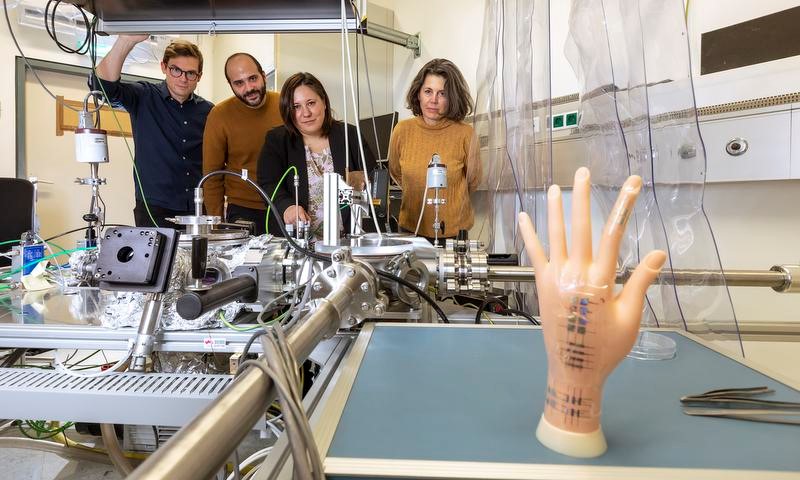Description

Disclaimer: Copyright infringement not intended.
Context
- Researchers at TU Graz in Austria have made significant strides in the development of an advanced 'artificial skin' or 'smart skin' prototype that surpasses the sensitivity of human skin.
Details
- Led by Dr. Anna Maria Coclite, the team has secured funding to explore real-life applications for their innovative creation, known as 'SmartCore.'
- This artificial skin can not only sense pressure and temperature but also humidity, making it a groundbreaking development in the realm of material science.
Top of FormSmartCore
- Developed by Dr. Coclite and her team at TU Graz, SmartCore is a three-in-one "smart skin" hybrid material.
- It closely mimics human skin, simultaneously sensing pressure, moisture, and temperature, converting these stimuli into electronic signals.
- With an impressive density of 2,000 individual sensors per square millimeter, the artificial skin is more sensitive than the human fingertip.
- Remarkably thin at 0.006 millimeters, it outshines existing electronic skin materials that only react to pressure and temperature.
Materials and Technology
- The success of SmartCore hinges on the materials used in its construction.
- A piezoelectric material generates an electric current when compressed or stretched, allowing the artificial skin to sense force or pressure.
- A smart polymer, sensitive to humidity and temperature changes, changes thickness, applying pressure on the piezoelectric material and generating an electrical current.
- Inspired by biomimicry, the materials used emulate natural phenomena observed in pine cones and plant leaves.
- Emphasis on biocompatibility ensures potential applications in the biomedical field, with the materials being bio-compatible for use among humans.

Environmental Considerations
- The team is committed to sustainability, using thin films for sensors, minimizing material usage.
- The prototype's thickest part, the substrate, uses eco-friendly materials like plastic or paper foil with better biodegradability.
Applications and Future Prospects
- Prosthetics: Smart skin could cover prosthetics, aiding amputees in regaining sensation, offering potential therapeutic benefits.
- Healthcare: As a sensor integrated with smartwatches, it could continuously monitor skin moisture, pH value, and temperature for health status tracking.
- Real-time Monitoring: Coclite aims to develop a wireless connection for real-time monitoring, transmitting data via Bluetooth to a smartphone app.
- Artificial Intelligence Integration: The future vision includes combining wearables and smart skin with learning artificial intelligence, creating a constant monitoring system for human vitals.
Challenges and Timeline
- Challenges include optimizing the prototype, achieving wireless detection, and collaborating with companies for real-time testing.
- The timeline includes hopeful developments over the next five years, inspired by similar groundbreaking work at Stanford University on soft integrated circuits that communicate with the brain.
Introduction to Artificial Skin
- Its primary goal is to replicate the functionalities of natural human skin.
Materials and Components:
- Smart Polymers: Fundamental to artificial skin, these materials change thickness based on variations in temperature and humidity. This responsiveness mimics the natural behavior of human skin, allowing the artificial skin to adapt to environmental conditions.
- Piezoelectric Materials: When compressed or stretched, these materials generate an electric current. In the context of artificial skin, they play a crucial role in sensing pressure and force, providing feedback similar to human touch.
- Nanostructures: Often, artificial skin involves the integration of nanostructures, such as nanorods. These structures contribute to the material's sensitivity, enabling it to detect minute changes in the environment.
Sensory Capabilities:
- Pressure Sensing: The piezoelectric properties of the material allow artificial skin to sense and respond to pressure changes. This is especially important for applications in robotics, prosthetics, and touch-sensitive devices.
- Temperature Sensing: By utilizing smart polymers, artificial skin can accurately sense temperature variations. This property is crucial for applications where temperature monitoring is essential, such as in healthcare or robotics.
- Humidity Sensing: The responsiveness of smart polymers to humidity changes enables artificial skin to sense moisture levels, replicating one of the functions of natural skin.
Biomimicry and Biocompatibility:
- Inspiration from Nature: The design of artificial skin often draws inspiration from biological systems, such as the behavior of pine cones or leaves that change shape based on environmental conditions.
- Biocompatibility: Ensuring that the materials used are biocompatible is critical, especially for applications in medicine. This enables the artificial skin to seamlessly integrate with the human body, reducing the risk of rejection or adverse reactions.
Manufacturing Techniques:
- Chemical Vapor Deposition (CVD): This precise technique is employed to create thin films and nanoscale structures in the materials used for artificial skin. It ensures accuracy and control over the properties of the final product.

Conclusion
As this field continues to evolve, the potential applications in healthcare, robotics, and human-machine interactions are vast.
|
PRACTICE QUESTION
Q. The quest for advancing artificial skin technology offers a glimpse into a future where man-made materials seamlessly integrate with the complexities of the human body. Discuss. (250 Words)
|










